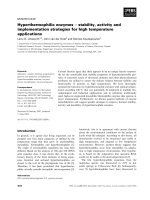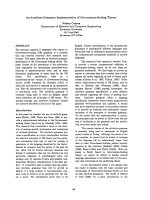Báo cáo khoa học: "Medical emergency teams: implementation and outcome measurement" potx
Bạn đang xem bản rút gọn của tài liệu. Xem và tải ngay bản đầy đủ của tài liệu tại đây (65.79 KB, 1 trang )
Available online />Technical advances in critical care medicine have seen the
rapid development and expansion of the specialty. Inevitably,
this has created a dichotomy between the standards of care
in the intensive care unit and those on general wards. To
redress this balance, teams of staff trained in critical care
have been established in some institutions to deliver critical
care throughout the hospital regardless of geographical
location. The medical emergency team (MET) is one
approach to this problem. It is reported that other initiatives
such as the establishment of trauma teams took up to
10 years to prove a reduction in morbidity and mortality. It is
therefore forecast that the MET will over time become
established practice, improving the quality of care for the
patients it serves.
The aim of this book is to provide a manual describing the
approach to creating a MET service and evaluating its
performance. The book presents a comprehensive overview
of the concept, including the theoretical underpinnings and
key drivers to maximise patient safety while identifying factors
that threaten. The pragmatics of establishing a service that
challenges the traditional boundaries of hospital care are also
explored. The editors and contributors include many of the
pioneers of this concept. As such they are better qualified
than any others to produce such a book.
Examples from practice are frequently cited from a global
perspective. There is a general consensus that a MET should
be pre-emptive and that certain quality indicators should
therefore be audited to determine its success. Contributors
openly highlight the barriers to establishing such a team, such
as issues of hospital culture and ownership of care. Aside
from the clinician’s perspective, the hospital administrator’s
views and the cost effectiveness of the MET are also
considered.
Chapters are self-sufficient units that each review one aspect
of the MET. For this reason there is some repetition across
the chapters. Perhaps a slight oversight has been not to
explore the allied heath care professional’s view, because
such staff frequently interact with METs and in certain
circumstances are recruited to be an active MET member.
Such a handbook will require periodic updating to ensure that
the evaluation of the impact and future developments of
METs is secured. Although this book is not essential reading
for every member of the critical care team, it is an important
guide to the dos and don’ts of establishing a MET.
Competing interests
The authors declare that they have no competing interests.
Book report
Medical emergency teams: implementation and outcome
measurement
Ann McGinley
1
and Rupert M Pearse
2
1
Critical Care Outreach Team, The Royal London Hospital, Barts and The London NHS Trust, London E1 1BB, UK
2
Barts and The London School of Medicine and Dentistry, Royal London Hospital, Whitechapel, London E1 1BB, UK
Corresponding author: Rupert Pearse,
Published: 16 April 2007
Critical Care 2007, 11:307 (doi:10.1186/cc5689)
This article is online at />© 2007 BioMed Central Ltd
DeVita MA, Hillman K, Bellomo R (Eds): Medical Emergency Teams: Implementation and Outcome Measurement,
1st edition. New York: Springer; 2006. 296 pp. ISBN 0-387-27920-2
MET = Medical Emergency Team.
Page 1 of 1
(page number not for citation purposes)









